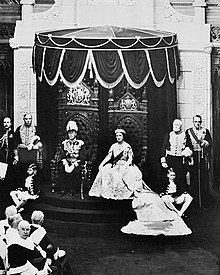
Back موافقة ملكية Arabic Royal Assent German Consentimiento real Spanish توشیح ملوکانه FA Sanction royale French Kraljevski pristanak Croatian Királyi jóváhagyás Hungarian Pengesahan kerajaan ID Sanzione regia Italian 国王裁可 Japanese

| Part of the Politics series |
| Monarchy |
|---|
 |
|
|
Royal assent is the method by which a monarch formally approves an act of the legislature, either directly or through an official acting on the monarch's behalf. In some jurisdictions, royal assent is equivalent to promulgation, while in others that is a separate step. Under a modern constitutional monarchy, royal assent is considered little more than a formality. Even in nations such as the United Kingdom, Norway, the Netherlands, Liechtenstein and Monaco which still, in theory, permit their monarch to withhold assent to laws, the monarch almost never does so, except in a dire political emergency or on advice of government. While the power to veto by withholding royal assent was once exercised often by European monarchs, such an occurrence has been very rare since the eighteenth century.
Royal assent is typically associated with elaborate ceremony. In the United Kingdom the Sovereign may appear personally in the House of Lords or may appoint Lords Commissioners, who announce that royal assent has been granted at a ceremony held at the Palace of Westminster for this purpose. However, royal assent is usually granted less ceremonially by letters patent. In other nations, such as Australia, the governor-general (as the Monarch's representative) has the right to dissolve the parliament[1] and to sign a bill.[citation needed] In Canada, the governor general may give assent either in person at a ceremony in the Senate or by a written declaration notifying Parliament of their agreement to the bill.
- ^ "The Australian Constitution – Section 5 – Sessions of Parliament – Prorogation and Dissolution". australianpolitics.com. Archived from the original on 20 October 2021. Retrieved 22 August 2021.